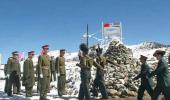Within the army, there is growing concern that New Delhi will allow the Chinese to retain the territory they have occupied in the last month, reveals Ajai Shukla.

In what the army is recognising as a repeat of Pakistan's 1999 Kargil intrusions, but this time by China in eastern Ladakh, troops of the People's Liberation Army continue consolidating their defences in the Galwan River and Pangong Lake areas, up to three kilometres inside territory that the Indian Army has patrolled and claimed for decades.
Just as the Kargil intrusions allowed Pakistani troops to dominate the Srinagar-Zojila-Kargil-Leh highway and threatened to cut off Ladakh from the north, the Chinese intrusion into the Galwan River valley allows PLA troops to overlook the strategic Darbuk-Shyok-Daulat Beg Oldi (DSDBO) highway and cut off the army's lone year-round connection with its isolated 'Sub-Sector North' (SSN), at the base of the Karakoram Pass.
PLA soldiers that have established themselves at the mouth of the Galwan River valley at its confluence with the Shyok River are just one-and-a-half kilometres from the DSDBO road.
The PLA apparently intends to dominate this road permanently.
Even as top Chinese officials declare the issue can be resolved through dialogue, PLA intruders are building bunkers while PLA engineers are connecting their forward troops with China's formidable road infrastructure on the Line of Actual Control.
Government sources conservatively estimate that the PLA has captured more than 60 square kilometres of Indian-patrolled territory in the last month -- equally divided between the northern bank of the Pangong Lake and the Galwan River sectors.
Chinese troops now block access to several Indian 'Patrolling Points' (PPs) along the LAC, which Indian army patrols have regularly visited for decades to assert their claim over the area.
Amongst them are PP-14, 16, 18 and 19.
At this time of the year, when the risk of Chinese intrusions is highest, it has been customary for the army's Udhampur-based Northern Command to move reserve formations into the area, ostensibly for 'training exercises'.
But this year, reserve troops were retained in their peacetime locations because of the pandemic.
Consequently, there has been a dire shortage of reserve troops to react to the PLA's multiple intrusions.
By the time the Northern Army was able to move reserves into the area, the PLA had already consolidated its hold over its newly acquired positions.
Army headquarters in New Delhi is coming round to the view that top generals in Ladakh have been caught napping. There is growing talk about replacing the corps commander in Leh, and even the Northern Army commander in Udhampur.
After the Kargil intrusions of 1999, which an enquiry blamed on 'intelligence failure', not a single general lost his job or was replaced. The army pinned the entire blame on a single brigadier in Kargil.
A retired defence intelligence chief, speaking anonymously, blames the current situation on an intelligence as well as an operational failure.
"The Chinese have always been ultra-sensitive to India expanding its presence in northern Ladakh. That is because this adjoins the Aksai Chin, through which China has constructed its strategic Western Highway that connects Tibet with Xinjiang," he says.
"When we built the 255 kilometre DBDSO Road through this area, why did the army not deploy troops on the eastern side of the Shyok, especially in the Galwan Valley, to protect the eastern approaches from the Chinese side?" the general asks.
The officer cites the Chinese intrusion in 2013 into Depsang, in the Daulat Beg Oldi sector, soon after India activated a landing ground there and beefed up troop numbers.
Within the army, there is growing concern that New Delhi will allow the Chinese to retain the territory they have occupied in the last month.
In public statements, Defence Minister Rajnath Singh has already conceded that the alignment of the LAC, and therefore the ownership of territory, is unclear in this area.











